Opening Day

(This may or may not be Ukraine. They claim it is, but even if not, it is a powerful image this in keeping with recent requirements for strict emotional value).
The information flow spewed at all parties in the UKR conflict is interesting. The energy expended in delivering direct-and-indirect reporting is high. The fighting is supposedly most savage at the moment in one town on a river. It is called Bahkmut. Descriptions of building-to-building fighting are raw and hark back to other momentarily famous towns like Verdun. That place was ground into rubble-flecked mud more than a hundred years ago.
The current kinetic conflict has elements of past and future. It is powerful history. The sorting out of a new world order is a vast process. Part of it is a reflection of global interests. In Bahkmut, for example, a town has become a multiple of “messages.” Thousands of young people are being killed or maimed each week, mostly by artillery or drone strikes.
We are only observers in this carnage, which is, of course, a proxy struggle. It is, as best we can tell, a regional struggle in a place that has known border disputes- on this border- for more than 400 years. The collapse of the Soviet Union thirty years ago left Russia wounded but still enormously provisioned with weapons of mass destruction. The NATO Alliance that opposed the Soviet Union expanded dramatically eastward with little comment about the sensitivity of a defeated foe.
The invasion last year is, in part, a reaction to that and an attempt to restore a part of an old order. Supplies across the spectrum, edible to lethal. That aid is from a variety of national sources, so naturally administrative support is required from the people who produced it. That includes intelligence, of course, which brings the term “proxy” closer to “partner.”
We know. It all depends on nuance for deniability or something else will happen in the branches and sequels component of planning. That is why the strike on the Ukrainian command bunker at Lviv was of interest. We have a pal who produces a daily summary of activity in the fighting. He provides useful discernment of the content of the information stream about what and why things are happening. We are grateful he has to wade through it all, nuance alternating with blunt force trauma.
Here is one that brought the reality home. We accept some information as useful and possibly true. At least confirmable from a distance. The ongoing war on Ukraine’s reliable electricity has featured use of drones and rockets. In early March, the Russian VKS (Aerospace Forces) reportedly used something new. They attacked a deeply-buried Ukrainian command post near Lviv, close to the Polish border. Some reports claim the facility was actually a “shadow NATO communications center.” The weapons used was advertised as a supersonic Kinzhal missile.

(Image courtesy TheAviationist.com)
Mr. Putin rolled out the Kh-47M2 Kinzhal missile in 2018. He stated it was a precision hypersonic aero-ballistic missile. Flight regime could be Mach-10 capable with the capability to carry conventional and nuclear payloads. This strike demonstrated a dramatic change in the myriad of things flying above Ukraine. The aspect that naturally caught our attention was the “deeply buried” capability. Those are the places where some of us worked. The ones left over from the old cold conflict in which defense meant building “hard targets.” The one at Lviv would have qualified. It was 128 Meters deep in the soil.
That was the part that provoked discussion. Press reporting claims hundreds were killed in the facility. It did not say what uniforms they were wearing. We assume it would have been a crowd similar to the NATO ones we worked with. Including people exactly like us. This happened around the same time as the Russian strike on our drone in the Black Sea and may be part of some larger narrative goal. Now that Opening Day festivities have passed, we might find out we are already opening up something else.
Copyright 2023 Vic Socotra
www.vicsocotra.com
A Week in Spring

This morning we were scrambling to find the pictures from that morning long ago in Jerusalem- afternoon? This memory thing is tricky, but there is digital evidence of past days. In that one, we were kneeling on the stones in Jerusalem where it is said Jesus walked. It was his last physical entry into the Holy City. Our visit there only had some minor echo of the Passion recalled this Sunday. There was something quite moving about our attempt to race through the New Testament in a couple days. We were doing the Stations of the Cross at one point, celebrating one end of the Holy Week while honoring the other. This was the shattered window of our hired car 🚗 through which someone put a part of the old city wall. Wrong license plates.
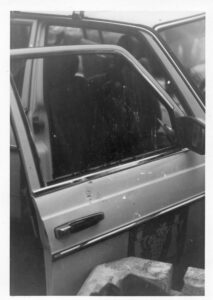
We are in another of those transformational times now. There are wonders and challenges. We don’t yet understand the consequences of the technologies we have embraced with abandon. This wider social development is likely to be profound.
At the moment, social information narratives are in conflict. There had been a “Day of Something” scheduled to occur at the Supreme Court yesterday. It was cancelled, since the somewhat bellicose justification for the demonstration was threatened by the nature of the shooting event in Nashville. The nature of the information battle is informative. We took an internal poll at Socotra House, the one not disclosed via standard information sharing speech protocols. We originally signed non-disclosure agreements about that, but that legal precedent appears to be under question with the other big legal thing we will be hearing about (at increasing volume) for the next twenty months.
We have experience watching blinking lights. As former workers in the Indications & Warnings trade, there are memories of times when just a few “indications” of change in the interest list were cause for concern. Standard stuff- truck movements, crates of objects of interest increasing. Signals stuff. Observations would be derived from increasing the sources and methods devoted to the problem. It could cause a color change in alert status and all sorts of other things would change in response. In our time, connectivity has essentially weaponized what used to be advertising. Old times? A few blinking lights could cause concern. In the information saturation of our new world the whole big panel seems to be alight and active in discord.
Like the weather, everything changes in our world. We are in one now, and are determined to learn from it. One of the challenges to pragmatism on the future is that there is likely to be a lot to learn.
Copyright 2023 Vic Socotra
www.vicsocotra.com

Publisher’s Note: Gentle readers, something strange came up the other day. Since the HQ was relocated to a denser-populated portion of the Commonwealth, there was interest in strategic inventory streamlining. Having just emerged from the production process on the three-volume WWII-Cold War project, the determination on next project issuance was on the table. We sent requests for stock information to the three distribution centers, and the response included one that was surprising. “Stones of the District” is something the Chairman did before expanding the product line. It is startling- color pictures throughout the book of the original monuments. Not recognizing production costs, the little volume wound up costing more than $20 on Amazon. There is one review- the Chairman did it- and not surprisingly he gave his work “five-stars!” Written in the mid-2000’s, the mile-by-mile examination of the original Boundary Stones of the District of Columbia was a microcosm of its energetic history. And there is a lot we wouldn’t try to do today, you know? So, the Chairman said get back with Amazon and offer a digital version of the book and give it away.
– DeMille
A Day for….

Yeah, we know. The recognized holidays of recent weeks symbolize the changing of the season. They blend it into something else. April’s arrival combines green meteorologic verve with the raucous celebration of Saint Patrick’s Day. Today’s celebration of Fools adds some luster as a special one, since it appears to include all of us. There is sentiment for designating some point in the tumult- a specific day- to mark a remarkable time of transition from one age to another.
That prompted discussion about the dimension of The Change this week. Some declared last Tuesday would have been a candidate for the memorial designation. There is enough uncertainty about exactly what is actually happening that ‘today’ might combine multiple things nicely. As a plus, it would ensure recognition of the idiots in all our villages as a matter of equity.
A note from Legal with “reply all” was first up at the morning session, Chock Full O’ Nuts providing some added energy. It reminded us of our obligation to support the Constitution, and the actions of officials entrusted with the faithful obligation to support it. We agreed, responding en masse that we naturally accept Legal’s crucial role in ensuring corporate and individual compliance.
Which also meant we had to scrap the topic for the morning- “Lawfare.” It got everyone riled up with something, including our local joke about whether we had to lawyer up for what might be coming. It was a little caustic in tone about how our legal system now frames a basic part of our governance. An expensive part.
Instead, we decided to just remember this day in the ways some of us prefer. It is Saturday and Belmont Farms is open. Given sufficient cash reserves and designated transportation, we believe it is also a convenient reference to a time when we realized to our shock that things really are a little different, you know?
It’s a Day for…
Copyright 2023 Vic Socotra
www.vicsocotra.com
Some Restrictions May Apply

(This is a “fair use” lo-res image from Fox for identification purposes only of the finest 20-seconds of TV in 2023. Apparently there is more to come).
Yeah, we were startled like you were yesterday afternoon. When we first heard it from Splash, we just assumed he had started early on the Belmont Farms, but then we saw it confirmed on the Flatscreen. We had rushed over to see the word on Mr. Trump’s indictment from that prosecutor in New York. It was a little mixed up- apparently the Russians are continuing to arrest journalists asking questions, which is what they used to do before news became the recitation of talking point. That accords the similarity between the Russian and American systems in the post-Cold War epoch. Arrest them and figure it out later. So, stand by. We had thought this matter was going away. Now we all have to live with it.
Accordingly, we had a choice about being alarmist or amused this morning. We chose both. Here’s the deal: the Chairman sent a text message last night saying this thing was as complex as the USAPatriot Act he reviewed more than twenty years ago as a government flunky. It was a bipartisan bill aimed at helping the response to 9/11. It also had some provisions that permitted government opportunities to identify terrorists not previously allowed. We had no idea that the targets also included all of us in the search for evil. That happened over time, of course, along with the people who decided what that was.
So, the amusement factor was high on Tuesday as we closed out the day. Senator Ted Cruz was a guest on one of the provocative news channels. The amusement arose when the Senator was asked not about school shootings- apparently subject of some proposed new laws. Instead, the questions were about a different bill. This one continues the tradition of cool if erroneous names for laws. It is called the “Restriction the Emergence of Security Threats that Risk Information and Communications Technology.” The official short term for that word-stream of law is the RESTRICT Act, though you are unlikely to hear it described that way.
Congress sums up the Act this way in their online summary: “This bill requires federal actions to identify and mitigate foreign threats to information and communications technology (ICT) products and services. It also establishes civil and criminal penalties for violations under the bill. That is assigned to the Commerce Department with a portfolio to “identify, deter, disrupt, prevent, prohibit, investigate, and mitigate transactions involving ICT products and services (1) in which any foreign adversary has any interest, and (2) that pose an undue or unacceptable risk to U.S. national security or the safety of U.S. persons. They also are required to identify stocks and securities of risk, and permit the President to compel mitigation or divestment.”
Most of us know it as “The TikTok Bill.” It is supposed to address the existing threat in America posed by that Chinese social internet platform. The small print doesn’t mention that entity by name, though. It also abridges some key provisions of the 1st Amendment and essentially does away with the 4th. (The one about your “papers” being private with a court warrant).
When asked about whether the TikTok Bill was going to accomplish, Senator Cruz was clearly not prepared to speak. It was embarrassing at first, but the dance off was delightful. The host of the show reminded the lawmaker that he was one of twelve cosponsors of the measure. That and the short moment before they cut to something else was about the best twenty seconds we have seen.
The PATRIOT Act was the sort of template for how the government now works. We struggle to find enough words for some of the titles, since the pages of new potential restrictions used almost all of the available inventory. So, there may be that to look forward to. Like they used to say in the advertising business. “Some restrictions may apply.”
Copyright 2023 Vic Socotra
www.vicsocotra.com
First Do No Harm

So, DeMille has been cranky. He claims it is the weather’s impact on his arthritis. Despite his still erect posture and residual military bearing, he wants to find an excuse promising things will get better. There is a case for optimism, after all. This day is starting well with bright blue sky, not a cloud to be seen. Temperature will be a little cool in morning but warming nicely for the brilliant artificial afternoon before the sun ducks behind the West Wing of the building.
So feelings were buoyant at the morning meeting despite the strange news. We discussed capitalizing the “S” and the “N” in those last two words but gave up. Since some of us had “information” as a warfare trade back in the day, we talk about the intensity and direction of the current narratives without much rancor. With the wonders of the digital age, it is useful to take a step back and try to understand what the streams of information are intended to accomplish.
You may (or may not) have heard much about the school shooting in Nashville. There is some horrific information flying around about it, including the sympathetic characterization of the perpetrator as a victim. Our assumption is that the story will be minimized in one of the operational narratives as inconvenient and blared in the other. There is more not yet disclosed, including a “manifesto” of motivation for the act, written by the shooter. We assume it will be handled with the same efficiency as other recent investigations in the news.
There are also some clinical questions that run directly into philosophic ones.
In the old Scientific Method, the impact of hormonal modification on behavior would have had a study before becoming a recommended course of treatment. There was one, five years ago, that suggested there could be negative outcomes. We have leapt beyond that, since the importance of “self validation” over biology is so essential that it superceedes medical ethics. In Latin, Primum non nocere, right?
“First Do No Harm” used to be part of the Hippocratic oath. But like many aspects of our new world colliding with the old, our new connectivity provides immersion in data and narrative. There was a blip on the flatscreen this morning about an effort to “ban” research on artificial intelligence. They were talking about a study over a limited amount of time so that experts could assess risks associated with new capabilities.
This is a curious but real thing. A memo flew around on the company internet a couple weeks ago warning us about a program called ChatGPT. It is said to be a labor saving algorithm that harnesses quantum computing to compile properly formatted text messages consistent in content with the desired effect. Without actual human intervention, except to turn it on.
Apparently the Experts are concerned that plausible irony, mild humor and simulated thought could enable society to have way too much time on their hands. With their machines. Things could get out of control.
We thought a small, controlled study should be done to see the effect of turning the “creative” side of our business
over to a program on DeMille’s laptop. We think someone should look at the long-term effects of turning creative jobs over to the boxes. We would be compensated for our idleness, of course, since we would back-up the machines. That might mean a lot of extra time to do other stuff. Naturally, we volunteered.
Copyright 2023 Vic Socotra
www.vicsocotra.com
Back in 2017 Forbes and what the regimin of hormones administered might d
Weather Report: Partly Cloudy, Small Craft Warnings

We have some interesting developments in the world we all call temporary home. We are not sure exactly how to characterize them. There have been some video clips of all sorts of them. Our Secretary of Homeland Security, a Cabinet Officer, was grilled pretty hard about the border for which he is- at least theoretically- responsible. Then there was news of another school shooting. A girl who was under some sort delusion about something perfectly obvious had been under psychiatric care for some time. People with credentials were aware of her problems, but nothing was done to keep her safe. Or, as it turned out, anyone else.
Look at the sweep of events! Apparently there will be new military bases constructed in the Republic of the Philippines, a nice country many of us recall fondly. That led immediately to a discussion about whether there will be conflict, which barely got started before someone asked about whether, technically, we already were. No answers on that, although it certainly appears there are those who believe that we are. They are just uncertain about where it might be, since the matter revolves around who “we” are.
There is much more, of course, but it all seems a little complicated. We used to think Russia and China were pals, since they shared governmental systems based on the maunderings of a guy named Marx. As it turns out, they still are. Pals, that is. But the nature of that friendship is about as odd as our former pals the Iranians are providing high-tech weapons to the Russians, which is the opposite of how things worked in the old days. Or at least the ones after we stopped providing them.
See? There is something askew about almost everything in the forecast. Nothing is quite the same. Russia’s system of governance fell apart more than thirty years ago, so this time the Chinese are taking the lead on trying to make a go of the old Marxian rhetoric. We suspect this try will fail as all the other attempts have. But there are likely to be some spectacular events as the world sorts out a new social order.
One of the stories was typical about the changes coming. The conflict in Ukraine is just one. We (no scare quotes) have stopped calling it “The.” Here is an example: “we” are running out of popular ammunition types to give them. We used to like the stuff that came in 155mm rounds. Apparently so much of that flavor of munitions has been used that there is an international shortage. Normally, we would consider that a sort of disarmament. Instead, it seems that the old Great Powers are simply using it up to disarm.
Like everything else in the forecast, it seems a little cock-eyed. Like American taxpayers subsidizing Ukrainian government pensions. We aren’t necessarily opposed to the idea, since there could be justification for such a practice. Of course, you would normally want to chat about it for a moment before shipping it off. We don’t seem to do that anymore. There is something pretty special about the Boomer generation. We are so well off that we are happy to bill this extravagance to the grandkids. Without discussion.
That is the way we roll. Or the way we used to roll, anyway. It was easier when the wheels were round, you know?
Copyright 2023 Vic Socotra
www.vicsocotra.com
Canal Zone

We got lost in the Canal Zone yesterday- “Zoning” is the term these days that shares some of the original meaning. First though, the morning news. There is a bunch of it.
Local stuff first. George Washington University, home of the Colonials, has announced they are abandoning that team nick-name. We understand the people who work there now consider the term ‘exploitive.’ The position on the Writer’s Section patio is that we were colonies back then, and even have a member whose family contributed a trooper in the 3rd Pennsylvania Infantry, 1776-81. He actually served in the conflict that enabled us to stop using the word altogether. In the same jumbled of disjointed historical reporting, we are apparently going back to the Moon. We were last there some fifty years ago, so it must be time to return.
None of us participated directly in the extra-orbital space flight series, but we have all been to the Canal and we were naturally sucked back into our personal histories. The Chairman’s grandfather had a minor role in the project, which in it’s time was as big a matter of national prestige as the landing on the Moon. There was a lot involved in it, including the territory of a colonial un-sovereign Columbia in a strange arrangement that apportioned part of their territory into a nation called “Panama” with a Canal Zone apportioned to the United States to complete digging the one-time French Canal across the isthmus of Panama.
Back then, the project consumed $350 million dollars. Adjusted for inflation, that is worth about $10.6 Billion today. Considering the amount of money spent to provide Ukraine defensive capabilities against Russian “special operations,” we suspect that is a little little light on the estimate. But as we have seen in recent times, it is the history itself that is being re-written to demonize the people who actually did the work. This is what they started with:
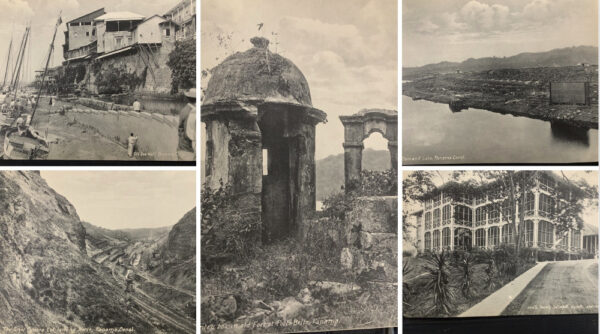
The images above were part of a package of pictures brought back from Colon. Each image is an 8X10 black-and-white depiction of what it was like in person. Above, the enormity of the job is apparent. Moving mountains, protecting old Spanish colonial fortifications overlooking the swarm of activities, including construction of special quarters for the nursing staff. Thousands perished in the effort. The Panama Canal Authority, the non-Colonial entity that now operates the system, claims that 22,000 people died across the scope of the thirty-years of building.
The French failed at a sea-level effort, 1881-1899. The Americans labored (1901-1914) with a new scheme, which was to raise ships up to the level of Lake Gatun for a 28-mile transit some 85 feet above sea-level. And then lower them again gently to the ocean by a sort of hydraulic elevator. Efficient? Takes about a half a day, and some of us have done it onboard. Nearly a million ships have done it, not adjusted for anything except the new wider PanaMax vessels using the new 1977 locks, have made the transit.
Some of the people that did it paid with their lives. Many, like the Chairman’s grandfather, did much smaller parts of the enormous project. These two ancient snap-shots from 1913 show one of his contributions, which was a bridge over a drainage ditch to safely carry the phone lines that would enable the enterprise to work.
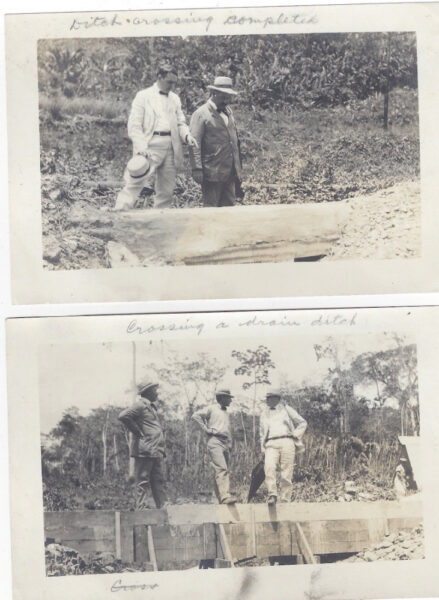
The two images show grandfather inspecting the work necessary to protect the new telephone cables laid over the canal’s smaller drainage ditches. The telephones would replace signal pennants to enable efficient opening-and-closing operations of the big Canal locks at maximum efficiency.
Some of us had been assigned to the various commands that the United States has operated to defend the ditch between the seas. With 110 years in service, the Canal has seen a lot tonnage moved east and west, or north and south if you look on a map. Some of the effort helped America build itself.
Meanwhile, feelings were rising. The 1977 Treaty with Panamanian Dictator Omar Torrijos specified a period of joint American and Panamanian control with the Canal reverting to Panama in 1999. The President who gave it away- Jimmy Carter- is in hospice care now. He thought it was an important gesture, and we honor his service even if we didn’t agree with the decision. We imagine he might think of us as colonialists.
It would be interesting to hear what the Chairman’s Grandfather thought, but he has been gone to his reward almost as long as the Canal has been in operation. We suspect he might not have approved. But heck, he was just responsible for some telephone cables. 110 years ago, he might just have been proud.
The note on his snap shot? “Ditch Crossing Complete.” We think that might be the best description of the whole thing.
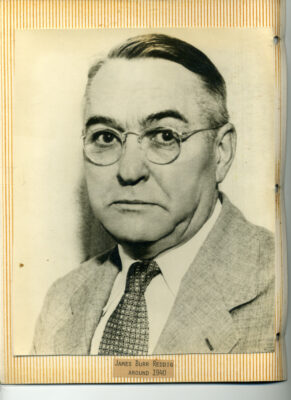
Copyright 2023 Vic Socotra
www.vicsocotra.com
Pictures From the Past
So, this represents some of the redecorating going on at the East Wing of Big Pink. You will note the variety of old black-and-white (hope that term isn’t cultural appropriation) on the shelf below the 72″ Television:

Grace had a bunch of hers she wanted to display- not unusual in a family with 9 siblings- and they go from the extreme right to the middle. She had seen the boxes of jumbled old photos from individual collections over the years in my swindling series of junk boxes. I grabbed a couple handfulls of my old unordered junk and found some that had passed mostly unseen over the years. This is three of Dad’s family in a pile of old snaps:

Upper of those is Dad’s family, my Aunt and Grandmother on the beach at lower left. A few years later Dad waits on the family porch in the lower right. That was not all that showed up, of course. There were some others, including three “unedited proof” images that startled me. They were taken in 1972 as part of the University of Michigan Chi Phi Fraternity’s annual update for that year’s House collective image. I looked at them, vaguely recalling we all knew we were about to start life with graduation in ’73. We would then have to figure out how to live in the “real” world. I think we were deliberate in having our pictures at the most extreme version of social fashion we would be likely to be permitted:

Whew!
Then two years with McGraw-Hill, leaving after an interesting social experiment that succeeded and failed in a grand attempt at adulthood. I had $10K in the bank, a not-inconsiderable then-amount of personal cash, and traveled for two years to visit pals and see some things we were not smart enough to know were actually supposed to be on the bucket list.
When I was down to a few hundred in the bank, I looked around for work ad saw more of the publishing stuff. On a whim, I stopped at a Nay recruiter to see if they would teach me to fly. They didn’t have anything in that direction for quotas, but recruiter LT Dan Erndal did have something for “air intelligence.” I didn’t think much about it but it sounded interesting. I signed. The rest, as they say, is history.
JR
Copyright 2023 Vic Socotra
www.vicsocotra.com
The Culebra Cut
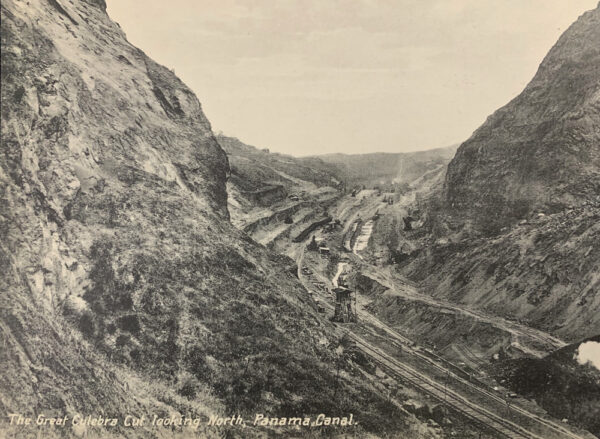
This is a morning with a touch of frantic family activity. We will have guests from both sides to show off the new digs to the kids who will have to clear things out when we are done with what we laughingly term “the Last Place.” The are grandchildren who will be accommodated under sunny skies with seasonal temperatures. In order to convey our helath and general well-being, we are cleaning up the stuff that we moved from the unit upstairs to the one on the first florr.
That involved some of the old work that is not quite complete. For example, the image above is from a set of twenty or thirty images our Grandfather collected in 1913 when he was helping The Phone Company complete the greatest construction effort in human history. At least the greatest one up to 110 years ago. A decent job of research would fill in the blanks on the net level of effort in the project- $350 Million back then. The glimpse at the Culebra Cut, the single most challenging component of that century’s Big Dig, shows you the scale of the effort.
There were other parts, of course. The French had tried to blow a sea-level canal through the sharp line of hills between the two great oceans. Due to the amount of dirt and rock involved and the diseases like Yellow Fever, they failed.
One of us made a point of visiting the venerable club where our connection to history occurred. Grandfather approached legendary Lieutenant Colonel George Goethals, third Chief Engineer of the Canal Project. He was innocently having lunch in a great wood-paneled hall with brilliant white linen covering the tables. Grandfather introduced himself as a functionary of the Bell System. He quickly advanced a plan to replace the communications system that would make the Canal a truly modern operating system. The key to it was to replace the nautical semaphore flag-crew who would raise flags to signal flooding and draining of the massive locks. Goethals arrived at a decision over his entree, and Grandfather was tasked to incorporate the telephone into the final design of the canal. No flags required.
The sea-level Canal could not be achieved. There was too much rock and too much height required. Instead, Goethals was determined to execute a plan with two artificial lakes as the key parts of the canal. The Gatun and Miraflores Lakes were created with four dams penetrated by massive “locks” of concrete and steel connecting them. Synchronizing the opening and closing of the gates between the lakes required teams of sailors who communicated in appropriate nautical fashion by raising and lowering pennants visible to the control tower. Grandfather proposed a means of communication that did not require fabric, ropes and pullies. Instead, they would be operated by instructions passed by telephone. Bell Telephones.
We passed the pictures around on the patio of the new unit. Holding the papers that our Grandfather collected more than a century ago to maintain his memory of the challenge was pretty cool. Wish he had lived long enough for us to have met him. Luncheons might have been a little livelier than usual. Maybe we can do something about that today!
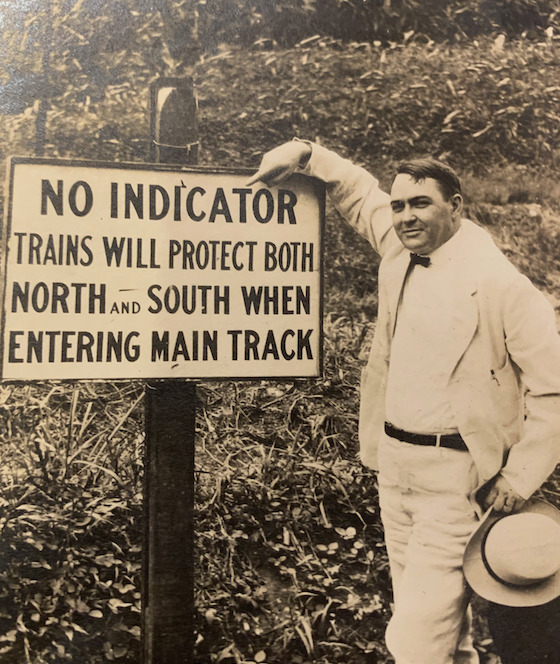
(Grandfather wanted his time with the message this sign preserved for history. As you can see, even a few words can have historic significance! Photo 1913 Socotra).
Copyright 2023 Vic Socotra
www.vicsocotra.com
Third Time is the Charm!

(District Stone SE9 is that dark block in the middle of the image, which took three tries to visit. It was not much different for the people who placed them all. In 1789, President George Washington gave personal orders to erect forty stones to mark the boundary of the intended capital city that would be named for him. The Stones were the first national monument of the New Nation. In 1791, he appointed Major Andrew Ellicott to survey the boundaries of the new Federal City. That required skilled workers, and Benjamin Banneker was identified as an expert surveyor who could lead and manage the effort. His participation is historic, since he had been born a free man of color, and his nomination was approved by Thomas Jefferson. Racial relations at the time were naturally strained by the legal status of slavery in the new Republic, but Banneker served as an official assistant surveyor and defied the extraordinary social barriers in place 2230-odd years ago. So, the first Monument of America also marked a signal achievement in our tumult of racial politics).
We are experiencing the unique changes in Virginia’s seasons now. It was similar to what the men who placed the Stones experienced: shifting weather conditions, long hours and precarious terrain made the surveying slow and difficult. After the team completed their calculations, Major Pierre Charles L’Enfant prepared the drawings for the city. So, you can see the various participants in a moderately large public project: Washington, Jefferson, L’Enfant, Ellicott and Banneker. They all had their fingers on the District Stones, and it is worth a moment to celebrate what they accomplished.
We talked about the District Stones yesterday, and the long series of minor challenges involved in visiting the site of the 40 that outline the District of Columbia. That requires a little work, since only 38 of the 40 remain where they were originally place. One of the two missing ones is supposedly in the private garage of a Maryland Department of Highways employee. It was misplaced during an attempt to set them all back in order. The one that is actually missing is represented by a small brass plaque in front of a liquor store not far from the North Stone.
There had been a series of adventures to find the Stones of the Distirct. The hunt ended, for me, with the rented powerboat passage across the vast and slowly moving Potomac River a few years ago.
Jon-Without (the “H”) and I were determined to finish off the hunt for the 40 Stones with a triumphant passage across the great river, and a last attempt to visit to the SE9 stone. That had defeated the dauntless party twice: Argo and I attempted the first approach on foot. The banks of the Potomac can be soggy and the Stone we sought had once been also used as a ferry landing. The level of the river had been up and down over the centuries. At this time the stone was almost as anonymous with other rubble on the shore. The Second Attempt to visit SE9 would be by kayak, rented from a concessioner on the east shore of the river.
A detailed de-briefing outlined the last attempts, the weaknesses and failures, and a plan was made to complete the adventure. We had pictures of the goal and objective. The stone was well defined, but had been moved once and was not protected by the green iron fence erected by the Daughters of the American Revolution in their centennial restoration in the 1890s.
Jon and I had been careful to complete the circuit. We had found the real North Stone, which has a more impressive version at the Northernmost corner of the District Diamond. The original one is not far away, and led to a decision not to join the ambiguity, which means there were technically 41 Stones in total with two missing. We had located the two now surrounded by housing project areas on the SE quadrant. There was great satisfaction in those attempts, and frank discussion about finding the office of the Maryland Department of Public Works to find the NE Stone that had been removed and was allegedly safely in the custody of an employee of the Department.
Today would mark “closure” on this attempt, and the completion of the Stone search. Then a couple drinks to celebrate and wrap up the book project about the search. It is still a doable deal, though the times have made the edges of the District a bit of hostile territory.
Jon and I were both still working in those days. That meant a Saturday was preferred for the last and most audacious attempt to close the project. We had arrived at the trip to the Last Stone after a remarkable adventure in the DC Impound lot, where SE8 is buried inside a vertical galvanized construction pipe. You can see the square top of it about four feet down from the lip of pipe. There was more to that story, though, and it caused a little tingle when we found the six WWII graves of the Nazis executed after they tried to poison reservoirs that slake the thirst of East Coast American families.
The diversion from the older story of the Stones to the newer one of World War II stones, not included in the 41 total, diverted our attention. Once we understood the mystery of the saboteurs landed by U-Boat in Long Island, their arrest, trial and execution, we were ready to find the Last Stone that erupts from the shallow water on the shore. A look back at the land approach on foot was a useful start. It meant taking our car to a place public land in the District, just a mile SE of the Stone in the Impound Lot, and the little garden with no stones that held the bodies of the Nazis executed by Mr. Hoover of the FBI.
Our attempt by rented paddle boats from National Harbor had deposited us in one of the wrong necks of the vast grey and brown river.
The feeling of the slow but insistent current was enough to raise a sense of unease. The look of the banks was imposing- not the landscape on which to beach the boat and plunge into the vegetation that had not been swept away. So, third time is the charm, and we thought we had thought it through.
OK. We don’t think the power of the mighty Potomac can be depicted in a manner that really conveys its strength. Stepping ashore, or even trying to traverse part of the muddy bank is a real challenge. If you are expecting a park-like serenity, you will not find it in the great drain from the hills inland. With rain comes enormous scouring energy to sweep trash from the urban sprawl that attends the river’s downward course. The debris tangles in the undergrowth in an astonishing mess that remains as the river lowers with the passing of the rain.
We will cut to the chase on this and not overwhelm you with data. There is an elegance to the crossing of the broad steam with the sight of the rebuilt Wilson Bridge across the water downstream. Half-seen things float around you, the absence of human contact in the midst of all that human habitation. It is quite an imposing experience, as is the beaching, and hop to the mud that covers the boots. The trash scattered up to what had been the high-water mark. Mostly plastic bottles, but with some other objects protruding from the muck that prudence would suggest we avoid.
We will not tell you about crossing the highwater mark to explore the thicket of brush and trees for the way forward. It had seemed so reasonable looking at the map, or from the satellite pictures that suggested the shore would be more inviting to our landing. That was not precisely the case.
We will leave you with the memorable moment in which we gave up, muck sucking on the boots, and the humid moist air beginning to join with sweat flooding down the back of a sweatshirt.
My last words to SE9, at least within a couple dozen feet, were of greetings and farewell. My advice to others who wish to visit, wait for a period of dry weather outside the Spring. There are no ceremonial Cherry Trees down by the impound lot, and the appearance of the Nazi graves was a significant reminder of some of the history we had tread. I think I expressed it more passionately at the time, but from the look on Jon’s face, the decision to end the hunt was unanimous.
The passage back to Alexandria was routine, as was the walk up to the Union Street Public House for a couple welcome cocktails. Looking back toward the river, we felt a certain perverse sense of accomplishment. We took sips of vodka tonic and thought about the Stones. All of them. And the men who put them there, in a world long ago.
“You know what I wanted to do when we finally found it?” I asked Jon.
He nodded, probably thinking of the same appropriate act to mark the scope of our adventure’s completion. It might have been a little disrespectful to America’s first monument, but it certainly would have felt right. We knew Andrew Ellicott and Benjamin Banneker’s boys, the work parties who shredded their way through forty miles of brush in precise straight line, must have done the same thing. And probably more than once.
Copyright 2020 Vic Socotra
www.vicsocotra.com
